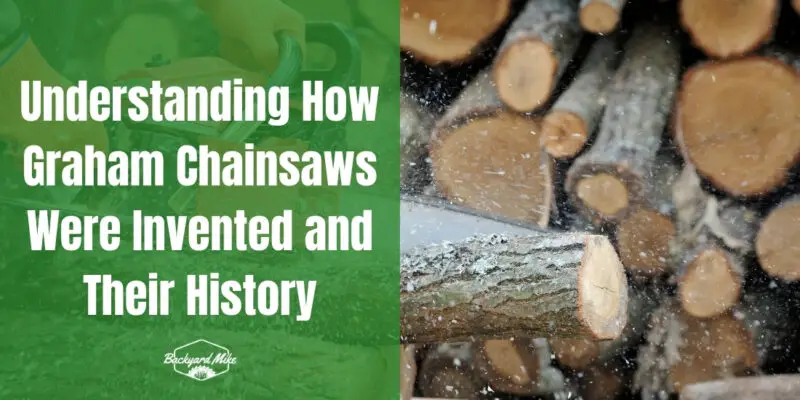Graham chainsaws revolutionized the timber industry with their innovative design, enhancing cutting efficiency and ergonomics. Emerging during a time when industry advancements were pivotal, Graham chainsaws contributed to faster woodcutting by implementing modern mechanics and safety features. These advancements echoed early innovations by Thomas Aitken and Bernhard Heine, evolving from medical tools to powerful logging devices. As chainsaw technology continues to advance, understanding historical milestones offers insight into their ongoing impact on woodcutting practices.
Key Takeaways
- Graham chainsaws were developed during the industrial transition of chainsaws from medical to woodcutting applications.
- The evolution of chainsaw technology was driven by innovators like John Aitken, James Jeffray, and Bernhard Heine.
- Companies like Stihl and McCulloch played crucial roles in advancing chainsaw engines and design features.
- Chainsaws improved logging efficiency, with modern designs incorporating safety and environmental enhancements.
- The chainsaw industry has seen significant economic impact and cultural symbolism, particularly in American capitalism and popular culture.
Early Innovations and Pioneers in Chainsaw Development
In the late 18th century, chainsaws were initially developed for medical purposes, revolutionizing surgical procedures. You might be surprised to learn that these early innovations were designed by Scottish doctors, John Aitken and James Jeffray. Their groundbreaking work led to the use of chainsaws as surgical tools, particularly in medical applications like cutting bone and assisting with childbirth. The chainsaw provided a more efficient and precise method for surgeries such as symphysiotomy, where widening the pelvis was necessary during difficult births. This advancement marked a significant shift from previous, less effective tools. Notably, the first mass-produced lightweight chainsaws emerged during World War II, significantly enhancing their utility beyond medical applications.
Key Figures and Their Contributions to Chainsaw Evolution
As you explore the key figures in chainsaw evolution, focus on pioneers like Charles and Andreas Stihl, who transformed chainsaw technology with their innovations in engine design and functionality. Understand the breakthroughs in chainsaw design, such as the shift to portable and single-user models, which enhanced efficiency and safety. Consider the role of influential companies that capitalized on these advancements, driving the widespread adoption and evolution of chainsaws across various industries. The Industrial Revolution increased demand for efficient wood processing, setting the stage for the development of the chainsaw as a solution to meet the needs of manufacturing, fuel, and construction sectors. Stihl's commitment to sustainability with electric-powered tools further underscores their influence in modernizing chainsaw technology.
Pioneers in Chainsaw Innovation
Although chainsaws are now synonymous with forestry and construction, their origins lie in the medical field. You might be surprised to learn that early chainsaw designs were created for medical applications.
Bernhard Heine invented the first chainsaw in 1830 to assist with surgical procedures, particularly for cutting through bone. Before this, in the late 18th century, two Scottish doctors, John Aitken and James Jeffray, developed an early prototype for medical use. These early designs of chainsaws were specifically used in symphysiotomy procedures to aid in childbirth, highlighting their initial medical purpose before transitioning to other uses.
These pioneers set the stage for the evolution of chainsaws from medical tools to essential equipment in various industries.
- Bernhard Heine: Invented the first chainsaw for surgery.
- John Aitken and James Jeffray: Created early medical prototypes.
- Early Designs: Used hand-cranked mechanisms with a watch chain.
Breakthroughs in Chainsaw Design
While chainsaws are now essential for various industries, their evolution is rooted in significant design breakthroughs and contributions from key figures.
You can trace this journey back to Bernhard Heine's osteotome in 1830, a pivotal step in chainsaw mechanics aimed at medical use. Fast forward to the 20th century, Andreas Stihl's creation of the first electric chainsaw in 1926 marked a shift towards practical logging tools. The Industrial Revolution catalyzed significant transformations in chainsaw design, further contributing to their development and widespread utility.
Then, Emil Lerp's introduction of the gas-powered chainsaw in 1927 revolutionized fieldwork with enhanced portability. These innovations were vital to the design evolution of chainsaws. Modern chainsaws, like the battery-powered chainsaws described in recent reviews, offer a quiet and portable alternative for smaller tasks, further expanding their versatility.
As technology advanced, safety features like chain brakes and anti-vibration handles became standard, highlighting a continued commitment to user safety and chainsaw mechanics efficiency.
Influential Chainsaw Companies
The evolution of chainsaws owes much to influential companies and visionary figures who revolutionized the industry. Understanding the role of key chainsaw manufacturers can deepen your appreciation of their historical impact.
- Stihl: Founded by Andreas Stihl, this company started exporting chainsaws in 1930, shaping the industry with innovative designs. Stihl's commitment to ergonomic design in their chainsaws has made them a leader in the market, ensuring user comfort and efficiency.
- McCulloch Motors Corporation: Established in 1943 by Robert McCulloch, it introduced lightweight models that transformed chainsaw use. The introduction of the McCulloch diaphragm carburetor in 1950 significantly improved the operation of chainsaws, enhancing their efficiency and reliability.
- Oregon: Joe Cox's mass production of chipper chains in 1948 set a new standard for saw chains.
These chainsaw manufacturers not only advanced technology but also contributed greatly to economic growth and productivity in forestry.
The Role of Graham Chainsaws in Timber Industry Advancements
Graham chainsaws have played a pivotal role in advancing the timber industry by enhancing both efficiency and productivity. They automate tasks that once required intense labor, leading to significant time savings. With chainsaw efficiency, you can cut trees faster and process wood more swiftly, meeting the ever-growing demand for timber products. This efficiency also contributes to timber sustainability by promoting selective harvesting, which minimizes waste and supports forest health. The first chainsaws were developed in the 1920s, with significant advancements in motorized saw technology leading to increased timber production. By reducing labor costs, Graham chainsaws make your operations more economically viable. The tools allow for precise tree removal, aiding in responsible forestry practices. In addition to improving productivity, they help maintain ecosystem balance, supporting community development and ensuring that you meet environmental goals in your timber-related endeavors.
Technological Milestones and Breakthroughs in Chainsaw Design
Technological milestones in chainsaw design have greatly transformed how you approach timber work, focusing on advancements that boost efficiency, safety, and sustainability.
Key innovations include the introduction of gas and electric chainsaws in the 1920s, which enhanced power and mobility. The shift to aluminum alloys in the 1950s made chainsaws considerably lighter, while anti-vibration systems developed in the 1960s improved chainsaw ergonomics. By 1980, Husqvarna had launched the Husqvarna 40, making chainsaws lighter with composite materials for longer use.
- Automatic chain brakes: Introduced in 1973, they revolutionized safety.
- Battery-powered models: Since 2012, these have reduced emissions, offering quieter operation.
- AutoTune function: Enhances performance and reduces emissions through fuel optimization.
These advancements guarantee you're equipped with tools that aren't only efficient but also align with modern environmental standards, fostering a sense of belonging to a community that values sustainability.
Cultural and Economic Impact of Chainsaws
When you explore the cultural and economic impact of chainsaws, you'll notice how they revolutionized the woodcutting industry by replacing traditional tools, greatly boosting efficiency and production. Chainsaws not only transformed logging but also found their way into popular culture, symbolizing chaos and violence, prominently through films like *The Texas Chainsaw Massacre*. As *The Texas Chainsaw Massacre* celebrated its 50th anniversary in 2025, it highlighted the chainsaw's symbolic role as a tool of defiance and structural irrationality. As you examine their influence, consider how chainsaws have reshaped both industrial practices and societal perceptions, reflecting the complex interplay between technology and culture.
Revolutionizing Woodcutting Industry
Although chainsaws were initially conceived for surgical purposes, their adaptation to the woodcutting industry marked a pivotal shift in forestry practices.
By enhancing cutting efficiency and chainsaw ergonomics, these tools revolutionized timber harvesting. You'll find that chainsaws are indispensable in forestry, offering unmatched speed and precision compared to manual methods.
Their introduction led to:
- Increased productivity: Loggers could work up to 10 times faster, remarkably boosting output.
- Economic growth: Local economies thrived as job creation in timber-related sectors expanded.
- Sustainable practices: Minimizing wood waste became possible, promoting eco-friendliness.
Modern chainsaws use chrome-tipped cutters for sharpness and corrosion resistance, contributing to their long-lasting performance and durability. As a member of the forestry community, embracing chainsaws means contributing to a legacy of innovation and efficiency, ensuring that you're part of a continuously evolving industry.
Chainsaw's Cultural Influence
Chainsaws haven't only reshaped the woodcutting industry but also left a significant mark on culture and economics. You're familiar with their cultural significance, especially within horror symbolism. They first appeared in cinema with *The Texas Chainsaw Massacre* in 1974, marking a turning point for horror films by representing industrial violence and societal chaos. The film critiques the dark side of American capitalism and the myth of the frontier, reflecting societal fears and unrest during its era. These tools of fear have since become iconic in popular culture, symbolizing terror and irrationality. Beyond horror, chainsaws contribute to chainsaw art, showcasing artistic versatility, and expanding their cultural relevance.
Economically, chainsaws support local economies by improving forest management and creating job opportunities in various sectors like firefighting and landscaping. They drive technological advancements, ensuring safety and efficiency in their diverse applications.
Modern Developments and the Future of Chainsaw Technology
To understand modern developments in chainsaw technology, it's essential to focus on the integration of AI and smart technology. AI integration in chainsaws now optimizes cutting efficiency by adjusting speeds based on wood density, ensuring both precision and safety. Additionally, eco-friendly innovations in design reduce emissions and noise pollution, aligning with sustainable practices. The global chainsaw industry was valued at US$4.01 billion in 2022, reflecting the significant impact of these technological advancements on consumer demand.
- AI-Assisted Cutting Technology: Adjusts cutting speed for efficiency and safety.
- Eco-Friendly Designs: Lowers emissions and noise, supporting sustainability.
- Smart Technology Integration: Sensors monitor chain tension and vibration for peak performance.
Battery-powered chainsaws have gained popularity due to their portability and efficiency. Advanced lithium-ion batteries and renewable energy sources enhance these tools' sustainability.
As demand for smart chainsaws rises, the future of chainsaw technology promises improved safety and environmental benefits.
Frequently Asked Questions
Who Founded Graham Chainsaws and When?
You might wonder about the founder history of Graham Chainsaws and when they started. Although details are elusive, understanding chainsaw evolution reveals how they transformed from medical tools to essential equipment in forestry and construction.
What Unique Features Distinguish Graham Chainsaws From Competitors?
Graham chainsaws fit your hands like a trusted tool, combining ergonomic design with innovative safety features. You'll feel part of a community that values precision and care, knowing your safety and comfort are prioritized in every cut.
How Did Graham Chainsaws Gain Popularity in International Markets?
You drove Graham Chainsaws' international expansion by embracing innovative marketing strategies that resonated with global audiences. You connected with communities through eco-friendly designs and reliable performance, fostering a sense of belonging and trust across diverse markets.
Are There Any Notable Patents Held by Graham Chainsaws?
You won't find Graham Chainsaws holding earth-shattering patent innovations in chainsaw technology. Their focus lies elsewhere, leaving the spotlight to others. However, their community connection and dedication to quality keep them a beloved choice among enthusiasts like you.
Has Graham Chainsaws Faced Any Major Controversies or Recalls?
You won't find major controversies or recalls for Graham Chainsaws. Safety concerns and product reliability are essential in chainsaw discussions. Being part of a community that values safety guarantees everyone uses reliable, well-maintained equipment.
Conclusion
You've explored the fascinating journey of chainsaws, from early innovations to modern advancements. Now, consider how Graham chainsaws revolutionized the timber industry, driving efficiency and precision. Reflect on the technological milestones that reshaped design and functionality. Imagine the cultural and economic impacts, changing how industries operate. As you ponder the future, think about how ongoing innovations might shape chainsaw technology further. Stay curious, as the next breakthrough might be just around the corner.


